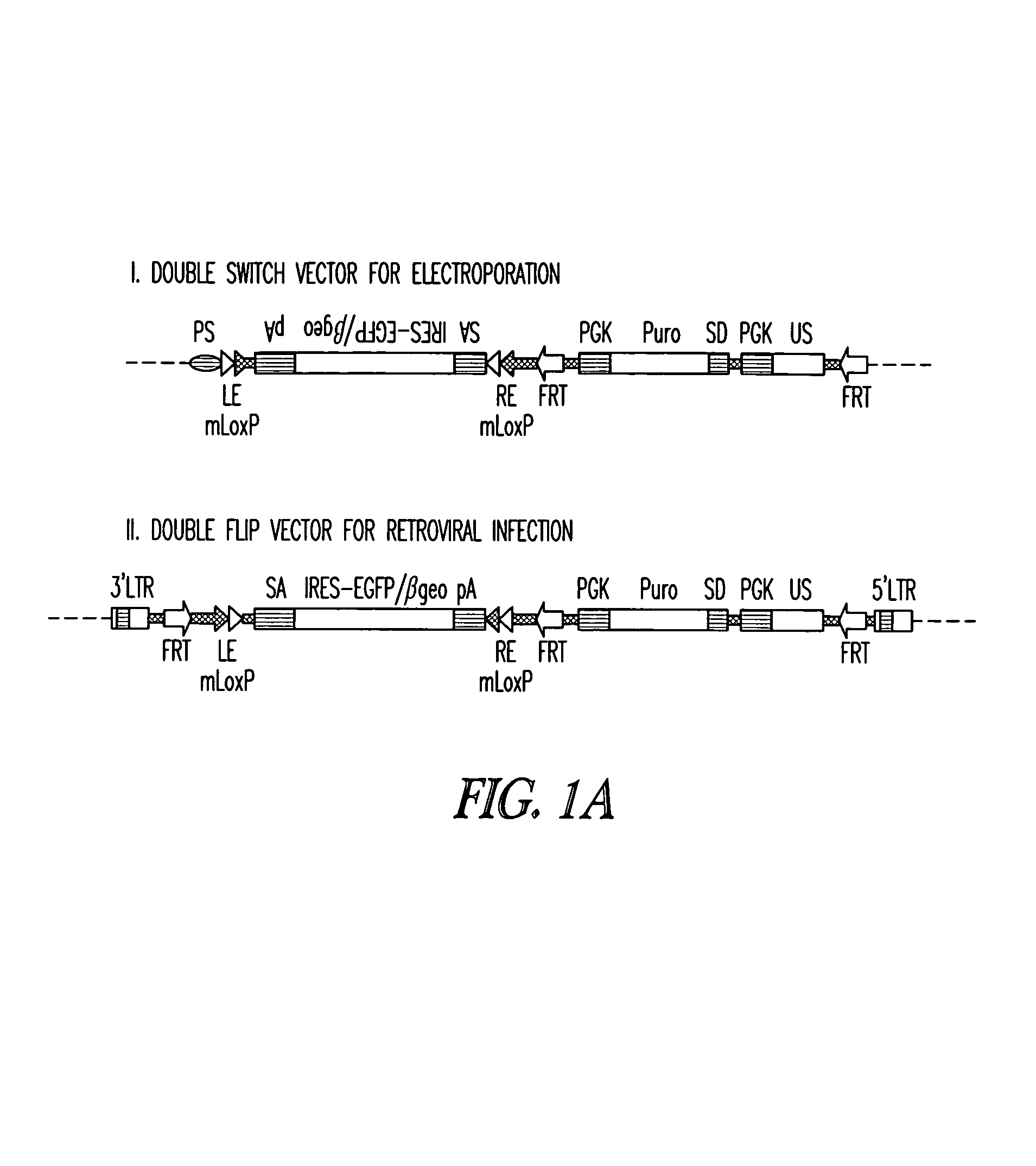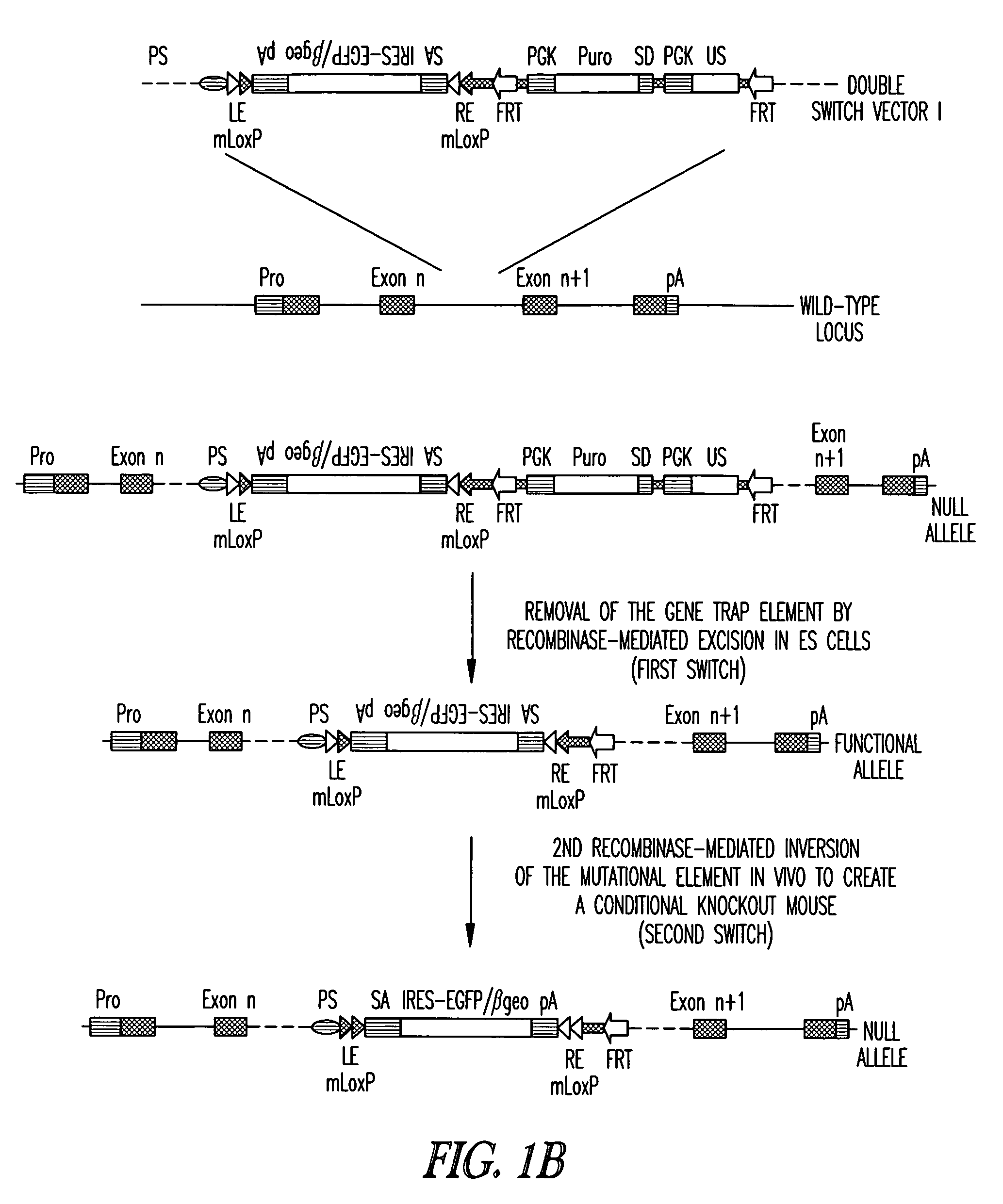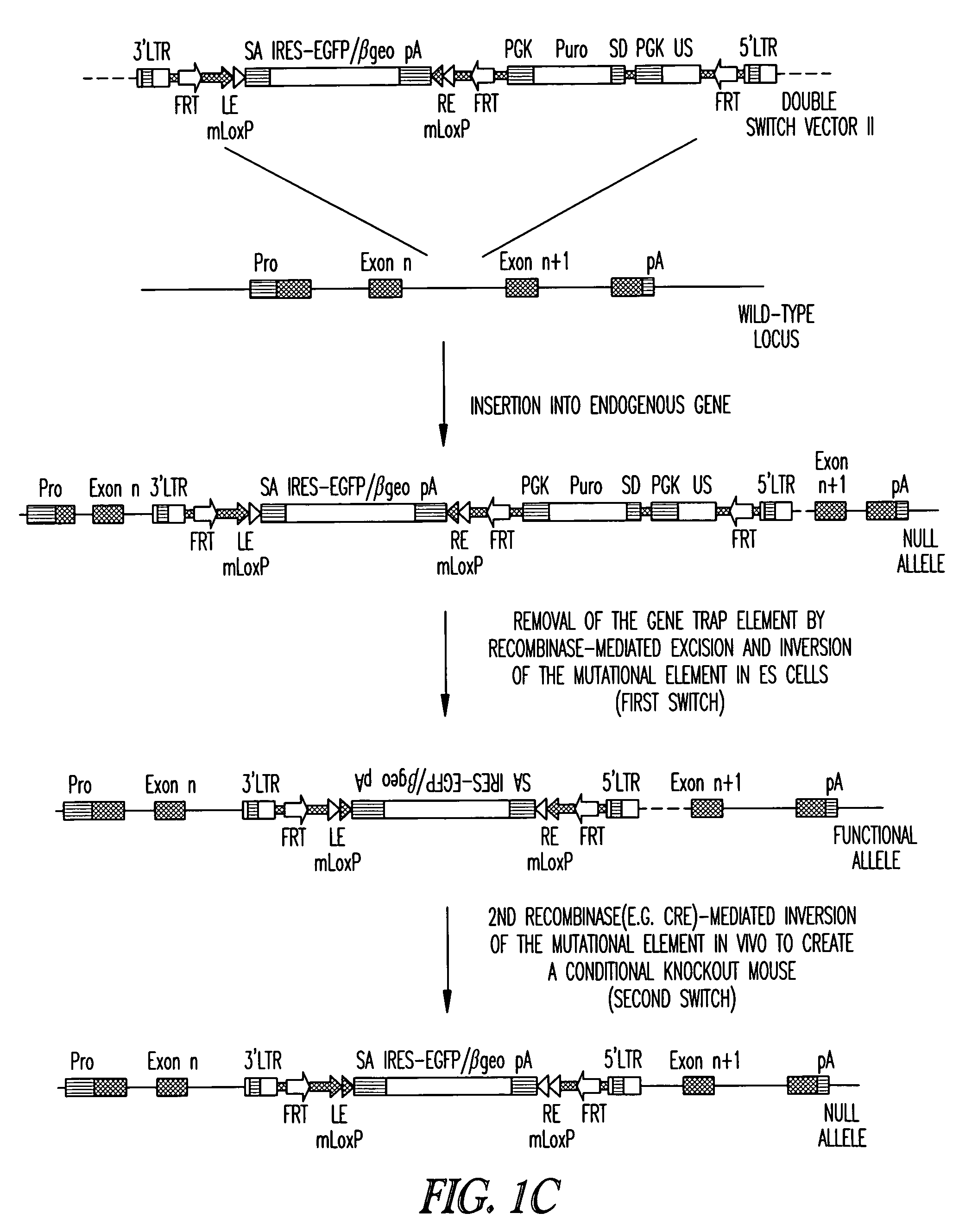[0011]The introduction of the vector into a host
cell, e.g., a prokaryotic
cell or a
eukaryotic cell such as a
plant cell or a
vertebrate cell such as a
mammalian cell, may be accomplished by any method to yield a genetically altered cell. The expression of the
marker gene in the gene trap cassette in the genetically altered cell allows the selection of clones with trapped genes and the identification of the trapped gene, e.g., by
rapid amplification of cDNA ends (3′ RACE). The gene trap element can be removed in cells, e.g., following selection, by introducing the appropriate
recombinase to the cell. For instance, by introducing the
recombinase or
DNA encoding the recombinase to the cell comprising the vector, the trapped gene is rendered functional (first switch). Moreover, vector
insertion within an
exon may result in disruption of the trapped gene even after recombinase-mediated excision of the gene trap element. To identify exonal
insertion events, a second gene trap element may be employed. The second gene trap element which lacks splice
acceptor and splice donor sequences is preferably located 3′ to the first gene trap element splice donor sequence and comprises a
promoter operably linked to a
nucleotide sequence which is unique to the vector relative to the host cell
genome into which the vector is introduced. Thus, if the vector inserts into an
exon, the expression of the second gene trap element produces a
RNA comprising the unique sequence followed by sequence from the endogenous exon, whereas if the vector inserts into an
intron, the unique sequence will not be spliced into the gene mRNA. RT-PCR with a primer that binds to the unique sequence permits the identification and sequencing of the cDNA to determine exonal integration.
[0013]Thus, the method of the invention greatly facilitates the investigation of the function of individual genes by a rapid extension of the conditional knockout approach to the entire
mammalian genome. The benefits of this approach include the potential to discover novel phenotypes and create useful
in vivo model systems for the study of
disease. The strategy is particularly well suited for studying embryonic development. Moreover, because the inactivation of many genes will be lethal or result in developmental adaptations, it is very useful to have the capability to inactivate or “knockout” a gene in an animal in a temporally or spatially controlled (conditional) manner. Thus, the invention provides a method for random insertional and conditional
mutagenesis of genes.
[0016]Further provided is a transgenic mouse, the
genome of which is augmented with a
recombinant DNA comprising a mutational sequence comprising a splice
acceptor sequence linked to a first
marker gene linked to a
polyadenylation sequence, which mutational sequence is in the same orientation as the endogenous gene into which the
recombinant DNA is inserted. The transgenic mouse has at least one phenotypic difference associated with the
recombinant DNA relative to a transgenic mouse comprising the recombinant
DNA in which the mutational sequence is inverted. In one embodiment, the “Double Flip” vector shone in FIG. 1 for
retroviral infection disrupts the endogenous gene in ES cells when it inserts into the
genome, since the mutational element has the same orientation as the trapped gene.
Transfection of ES cells with FRT recombinase allows selection of clones in which the gene trap element has been excised and the mutational cassette has been inverted, resulting in a functional
allele (first switch). When crossed with a mouse expressing
Cre recombinase under tissue-specific and / or temporal control, the presence of
Cre recombinase results in inversion of the mutational cassette (second switch) and gene disruption.
[0017]Also described herein is a rapid and efficient method that greatly simplifies the production of vectors for conditional
gene targeting (Universal. “Flipout” vector). Thus, in this embodiment of the invention, the vector is a
homologous recombination targeting vector for conditional gene inactivation. The method allows the construction of
gene targeting vectors for any gene by performing routine PCR and vector
ligation. A transcriptionally silent, mutational element within the targeting vector is activated by a recombinase, thereby allowing spatial and / or temporal control of gene inactivation. As described hereinbelow, the method employs a
genetically engineered vector comprising a mutational sequence that is transcriptionally silent but can be inverted to truncate and inactivate a targeted gene in a conditional manner. The vector comprises operably linked: a mutational element cassette and preferably two
selectable marker cassettes for positive and
negative selection. The mutational element cassette comprises operably linked: i) a first site-specific recombination sequence for a first recombinase; ii) a mutational sequence which comprises a splice
acceptor sequence linked to a first
marker gene linked to a
polyadenylation sequence; and iii) a second site-specific recombination sequence for the first recombinase. The positive
selectable marker cassette comprises operably linked: i) a first site-specific recombination sequence for a second recombinase; ii) a first
promoter operably linked to a second marker gene; and (iii) a second site-specific recombination sequence for the second recombinase. The mutational sequence is inverted relative to the second marker gene.
[0020]Thus, the invention provides a
gene targeting vector comprising a transcriptionally silent, mutational element within the targeting vector that is activated under control of a recombinase, thereby allowing spatial and temporal control of gene activation. Because the mutational cassette is self-contained and transcriptionally silent until activated, the invention obviates the laborious
subcloning and precise placement of recombinase recognition sites currently required to create a gene targeting vector for conditional
mutation, allowing the simple insertion of sequences upstream and downstream of the desired site of gene truncation. Thus, a conditional targeting vector can be simply constructed for any gene by determining an
intron and the flanking sequences within the gene, the targeting vector allows insertion of the cassette in this
intron and subsequent gene truncation and inactivation when desired. The invention also describes a method of preparing that vector, e.g., using routine molecular biological techniques such as PCR and
DNA ligation, and a method of using such a vector.
 Login to View More
Login to View More 


